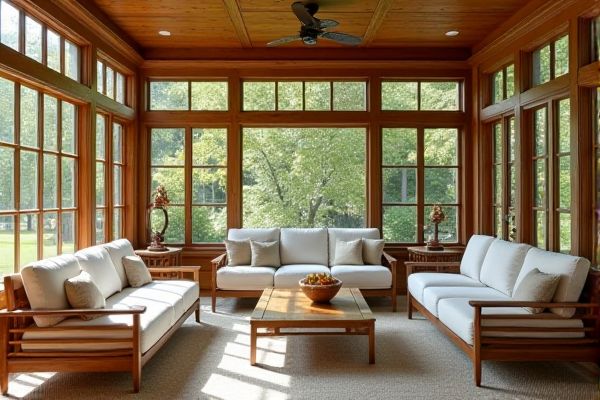
Teak sunroom furniture offers exceptional durability and resistance to moisture, making it ideal for long-lasting outdoor use, while acacia provides a more affordable option with a beautiful grain but requires regular maintenance to prevent weather damage. Explore the rest of the article to discover which wood suits your sunroom style and care preferences best.
Table of Comparison
| Feature | Teak Sunroom Furniture | Acacia Sunroom Furniture |
|---|---|---|
| Durability | Highly durable, resistant to rot and insects | Durable but less resistant to moisture and pests than teak |
| Maintenance | Low maintenance; requires occasional oiling | Moderate maintenance; needs regular sealing or staining |
| Appearance | Elegant, natural golden-brown color that ages gracefully | Warm, rich color with natural grain variation |
| Cost | Higher price due to premium quality and longevity | More affordable and budget-friendly option |
| Weight | Heavy and sturdy | Lighter and easier to move |
| Environmental Impact | Often sourced from sustainable plantations | May vary; choose FSC-certified options for eco-friendliness |
Introduction to Teak and Acacia Sunroom Furniture
Teak sunroom furniture is prized for its exceptional durability and natural resistance to moisture, making it ideal for indoor-outdoor transitional spaces. Acacia sunroom furniture offers a more affordable yet sturdy alternative with rich, varied grain patterns that enhance aesthetic appeal. Both wood types require minimal maintenance and provide a warm, inviting atmosphere suited for sunrooms.
Key Differences Between Teak and Acacia Wood
Teak wood is prized for its exceptional durability, natural oils that resist water and pests, and rich golden-brown color, making it ideal for long-lasting sunroom furniture. Acacia wood offers a more affordable alternative with a distinctive reddish-brown hue and moderate resistance to moisture, though it requires regular maintenance to prevent cracking and warping. Your choice between teak and acacia sunroom furniture depends on the desired balance of longevity, aesthetic appeal, and budget for outdoor or indoor sunroom environments.
Durability and Longevity in Sunroom Conditions
Teak sunroom furniture outperforms acacia in durability due to its high natural oil content, which resists moisture, insects, and decay, making it ideal for humid sunroom conditions. Acacia furniture, while sturdy and moderately resistant to elements, requires regular sealing and maintenance to prevent warping and cracking over time. Teak's inherent weather and rot resistance ensures longer-lasting sunroom furniture that maintains structural integrity with minimal upkeep.
Maintenance Requirements: Teak vs. Acacia
Teak sunroom furniture requires minimal maintenance due to its natural oils and high resistance to moisture, insects, and decay, allowing it to age gracefully with just occasional cleaning and oiling. Acacia furniture needs more frequent upkeep, including regular sealing or oiling to prevent cracking, warping, and fading caused by exposure to humidity and sunlight. Choosing teak over acacia significantly reduces maintenance efforts while ensuring long-lasting durability and preserved aesthetic appeal.
Aesthetic Appeal and Color Variations
Teak sunroom furniture offers a rich, warm golden-brown hue that darkens beautifully over time, providing a classic and elegant aesthetic with natural grain patterns. Acacia furniture presents a more diverse color palette, ranging from light amber to deep reddish-brown tones, adding vibrant and rustic charm to your sunroom. Your choice depends on whether you prefer teak's timeless sophistication or acacia's dynamic color variations to enhance your space's visual appeal.
Comfort and Design Options
Teak sunroom furniture offers superior comfort due to its natural oil content, which makes it smooth, durable, and resistant to moisture, while acacia provides a sturdy yet slightly harder feel with a unique grain pattern that enhances rustic design aesthetics. Design options for teak often feature classic, elegant styles with rich golden hues that age gracefully to a silver patina, whereas acacia furniture presents more varied finishes and bold colors, catering to contemporary and eclectic tastes. Both materials allow customization, but teak's fine texture lends itself to more intricate craftsmanship, enhancing comfort through ergonomic design.
Price Comparison: Teak vs. Acacia Furniture
Teak sunroom furniture typically commands a higher price due to its durability, natural oils, and resistance to weathering, making it a long-term investment. Acacia furniture offers a more budget-friendly option with attractive grain patterns but may require more maintenance to prevent wear and moisture damage over time. Your choice between teak and acacia should consider both the upfront cost and the expected lifespan based on the furniture's exposure to sunroom conditions.
Sustainability and Eco-Friendliness
Teak sunroom furniture is highly valued for its natural durability and resistance to pests, requiring minimal chemical treatments, which enhances its sustainability profile. Acacia furniture, sourced from fast-growing trees, offers a renewable alternative with efficient growth cycles that reduce deforestation impact. Both wood types benefit from certifications like FSC, verifying responsible forest management and supporting eco-friendly choices.
Best Uses for Teak and Acacia in Sunroom Spaces
Teak sunroom furniture excels in durability and resistance to moisture, making it ideal for humid or sun-exposed indoor spaces where longevity is essential. Acacia furniture offers a more affordable, stylish alternative with natural water resistance, suited for decorative pieces or low-traffic sunroom areas. Both woods complement sunroom aesthetics, but teak's oil-rich composition ensures superior protection against wear and fading compared to acacia.
Final Verdict: Choosing the Right Wood for Your Sunroom
Teak sunroom furniture offers unmatched durability and natural resistance to moisture, making it ideal for long-lasting outdoor use, while acacia provides an affordable alternative with attractive grain patterns but requires more maintenance to prevent weathering. Your choice depends on balancing budget with longevity, where teak's premium quality justifies the higher cost for enduring beauty. Opt for teak if low maintenance and resilience are priorities; select acacia if you prefer a budget-friendly option with periodic upkeep.
 homyna.com
homyna.com